
Finland - trams
For a full scale picture, please click on the picture shown !
Trams of City of Helsinki

This category is for trams in Finland. Currently there are two tram networks
in the country, in the cities of Helsinki and Tampere. But there are plans to start new tram
networks also in Turku and Vantaa sometime fairly soon.
The Helsinki tram network is metre gauge and with DC 600V currency.
First electric trams started in Helsinki in September 1900. This one is one of the latest trams in Helsinki, model Artic, built by
Transtech. Transtech is now part of the Škoda group of Czech republic and Škoda in turn is owned by the Volkswagen group.
Picture from the Vallila depot 30.5.2016 by Ilkka Siissalo.
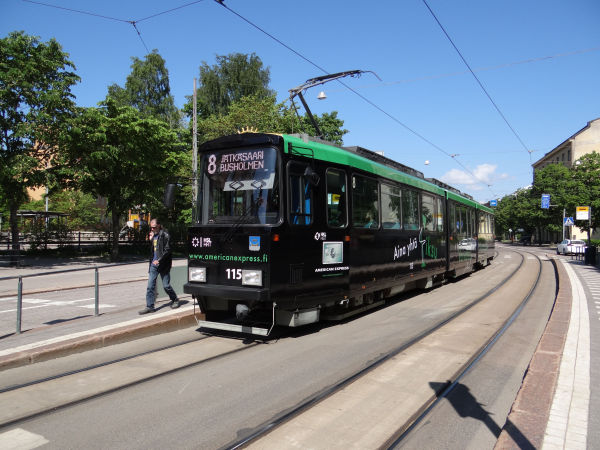
There are still some of these left. These are the type NrI or NrII built by Valmet and Strömberg in the 1970s and 1980s. Some of these
have fully covering advertisement tapes, such as this one NrII number 115. This one also has an added low-floor middle section
which some of these trams received fairly lately.
Picture from the Vallila depot in Helsinki 30.5.2016 by Ilkka Siissalo.
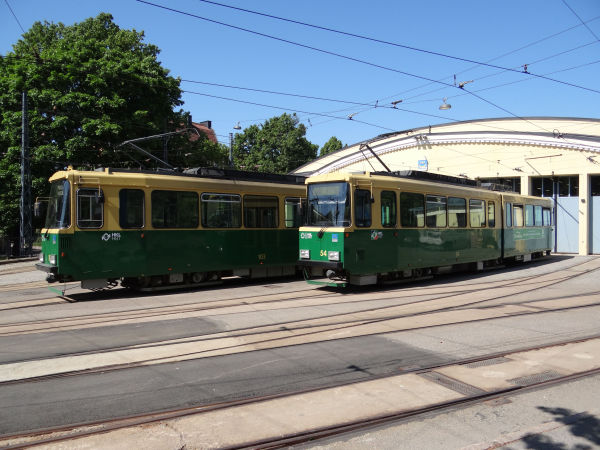
The series NrI is from the mid 1970s. First ones appeared in traffic 1973. When HKL later ordered more trams, the new series
got the name NrII. Seen from the outside, they are very similar. In this picture the no. 103 on the left is an NrII and the no. 54
on the right is of the series NrI. If you look closely, you may notice that a small ventilation grille by the front is in
a different place and some of the undercarriage "boxes" are different too. But this picture also shows the difference in length
after addition of a low-floor middle section. Most of the NrII and some of the NrI trams received a third low-floor piece
beginning from 2006. After such an addition the class of the tram such as the 103 here is MLNRV II which stands for
"matalalattiainen nivelraitiovaunu II" or low-floor articulated tram II.
Picture from the Vallila depot in Helsinki 30.5.2016 by Ilkka Siissalo.
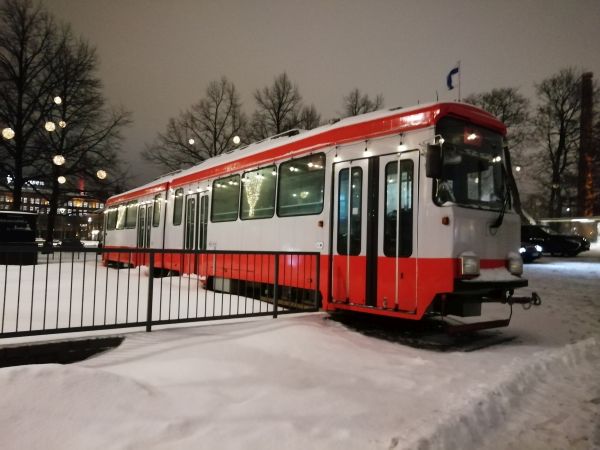
This is how the NrI and NrII trams were painted when they were new. This individual was repainted in its original colours and was
used as a kiosk for a while in Tampere.
Picture from Tampere 22.1.2010 by Petteri Holopainen.
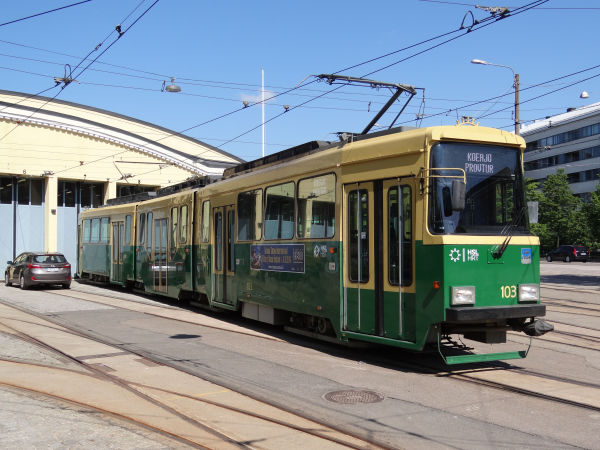
Another view of the NrII no. 103. Here you can see clearly the added middle section. These middle pieces were added in the beginning
of 2006 and they were made in Germany.
Picture 30.5.2016 from Vallila depot in Helsinki by Ilkka Siissalo.
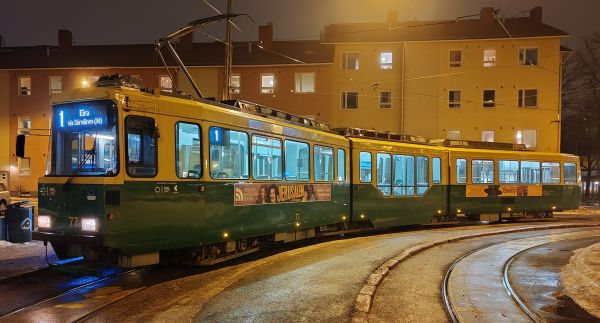
A similar NrII tram like in the picture above. The tram no.77 is from the 1970s, but the low-floor middle section was installed
decades later. Yet, it was done in style and it looks like it would always have been a part of the tram. Cudos to the engineers !!
Picture from the Käpylä turning loop of line 1 by Kari Wikström (the driver of this tram) 26.2.2024.
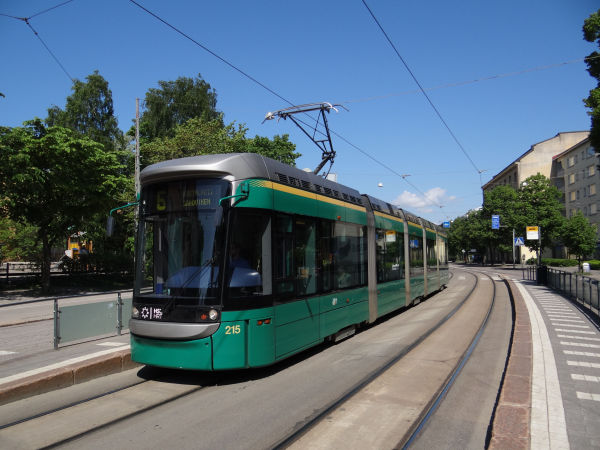
This is a Bombardier/ADtranz Variotram. HKL bought 1998-2004 altogether 40 of these low-floor trams. From the very beginning they were
very disappointing. Especially their small wheels and drive motor technology caused so much problems that at one point
HKL hired lawyers and threatened to return the trams to their producer. Things became even more complicated as ADtranz ceased
to exist and the product rights went over to Bombardier. After a fight they reached an agreement and for a while Bombardier
rented space from HKL's depot and took care of the maintenance of these trams with its own personnel. But in 2017 both HKL and
Bombardier had to admit that these trams will not last as long as was planned. Their car bodies are breaking and also electric
systems are frequently failing. These trams were all returned to Germany and vanished from Helsinki.
Picture by the Vallila depot 30.5.2016 by Ilkka Siissalo.
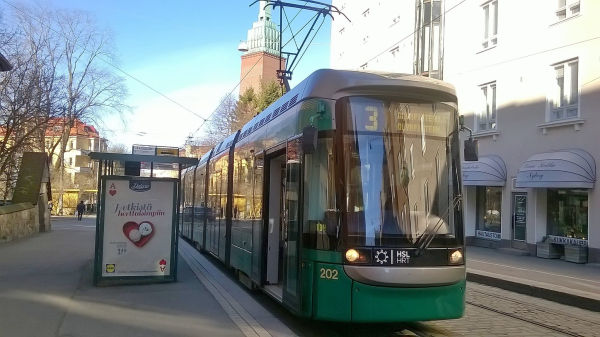
Another Variotram, the no.202 is here waiting on line 3 for the officially announced departure time in Eira.
Picture 29.3.2017 from the Eira hospital stop by Kari Wikström.
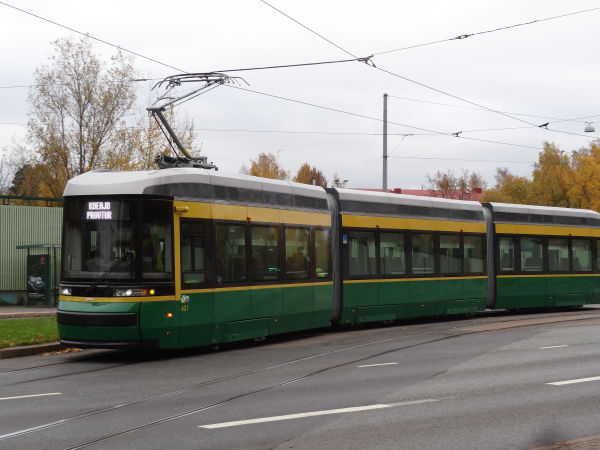
Prototype Artic tram no. 401 when it was new 19.10.2013. After the Variotrams, when HKL needed even more trams, a public
tendering was organised, which became a very complicated matter. After evaluating a lot of existing alternatives, HKL
went for planning and designing the new tram itself. The trams were then built by Transtech. Two prototypes ran in normal
traffic for almost 3 years before series trams were rolled out in 2016. Later the prototypes were sold to Germany, to
Schöneiche near Berlin.
Picture of one of the Artic prototypes from the Koskela depot 19.10.2013 by Ilkka Siissalo.
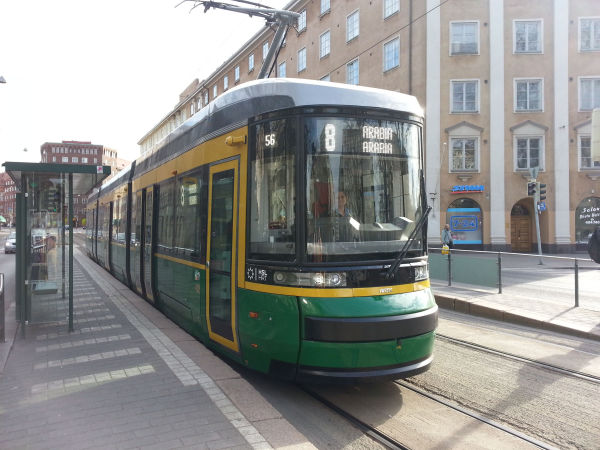
Another view of a prototype Artic tram in traffic.
Photo from Runeberginkatu, Helsinki 26.4.2014 by Ilkka Siissalo.
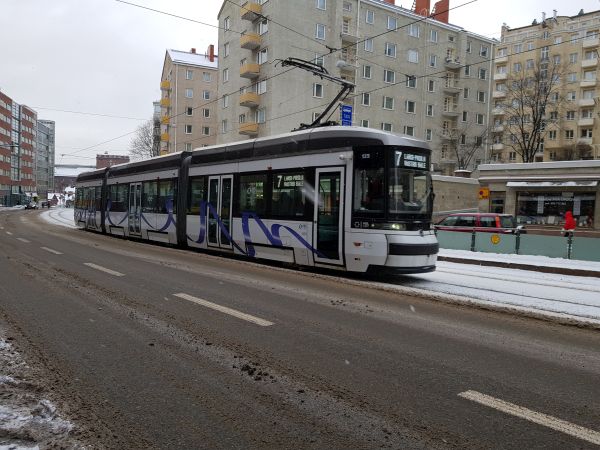
During 2017 one of the new Artic trams of Helsinki got a fairly stylish special taping in blue and white to celebrate Finland's
100th anniversary of the country's independence. Here the independence tram no. 404 is seen on line 7 running on Hämeentie.
Picture 25.1.2018 by Ilkka Siissalo.
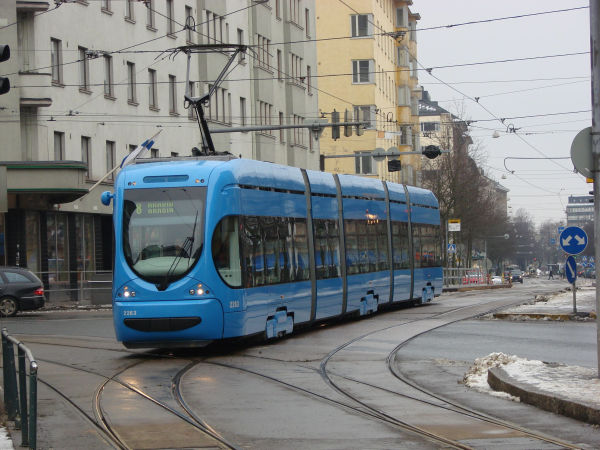
Before designing and buying the Artic trams, HKL evaluated a number of existing models. One of them, a Croatian model called
Crotram was even used in normal traffic in Helsinki for several months.
Picture of the loaned Crotram seen here near the Sörnäinen metro station 5.2.2008 by Ilkka Siissalo.
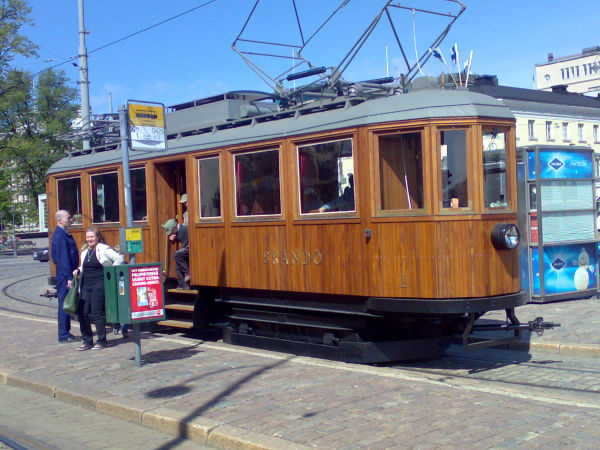
1915 to 1928 there was a private tram company linking the island of Kulosaari (in Swedish Brändö) to Helsinki. Originally there was
a steam ferry that took the trams over the small strait to the island. Later when the company, Brändö Spårvagns Ab, was fused with the
city tramways, the peculiar looking wooden wagons were for a long time used on the route to Käpylä. Tramway to Kulosaari was closed in 1951.
Much, much later the remains of one of the 1915 built Kulosaari/Brändö wagons was found and based on the remains a new replica was built
and completed in 2007. This new wagon looks like the old ones, but the technology used, like the motors and bogies, have been taken from
a Valmet built 1950s wagon.
Picture of the Brändö replica wagon at Kauppatori (Market square) 22.5.2008 by Ilkka Siissalo.
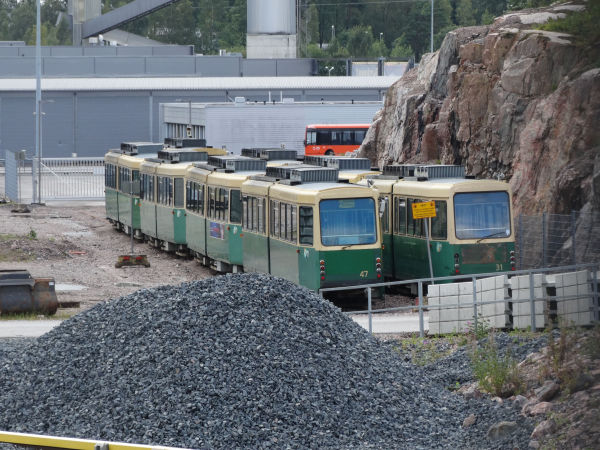
Time is out for these eight class NrI (nivelraitiovaunu I = articulated tram I) trams. They entered service 1973-75 and now they have ended
at the scrapyard, waiting for someone to cut them into pieces. They have already lost their pantographs. No. 31 back to the right is Finland's
first articulated tram and at the same time Europe's first thyristor technology steered tram.
Picture from Roihupelto bus depot 17.8.2016 by Ilkka Siissalo.
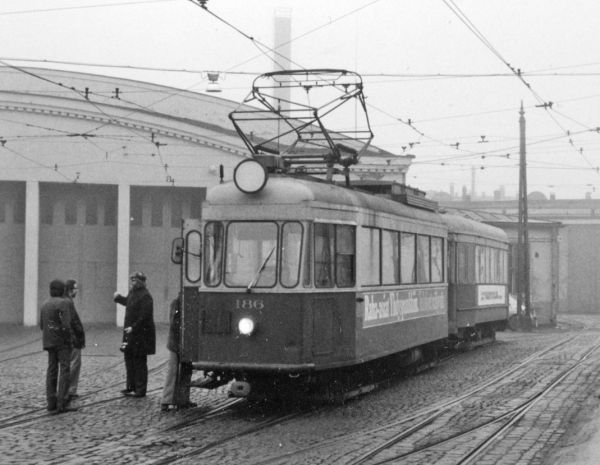
HKL trams no. 181 to 186 were nicknamed "Asean arkku" (the coffin of Asea) because of their shape. They were ordered from Asea in Sweden in 1939
in the hope that these new trams could enter service before the planned Olympic sports festivals in Helsinki in 1940. However, war broke out
first and the Olympics were cancelled. Here the "coffin" no. 186 is seen together with some ten years or so older trailer wagon 686, also built
by Asea. This was a special ride for the members of a tram historic association.
Picture from HKL's Vallila depot 9.3.1975 by Eljas Pölhö.
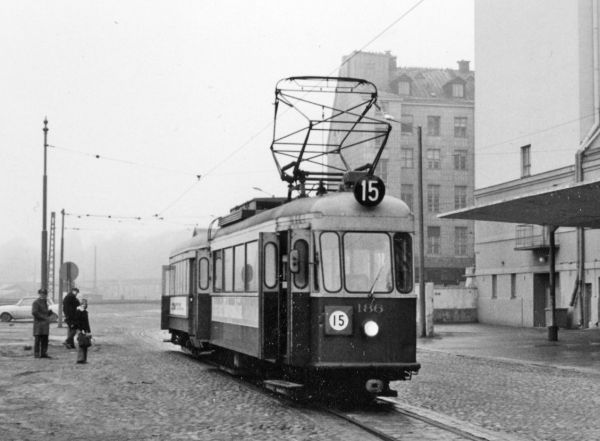
The same combination as above, HKL 186 plus trailer 686 during their special ride for tram enthusiasts.
Picture from Hietalahti 9.3.1975 by Eljas Pölhö.
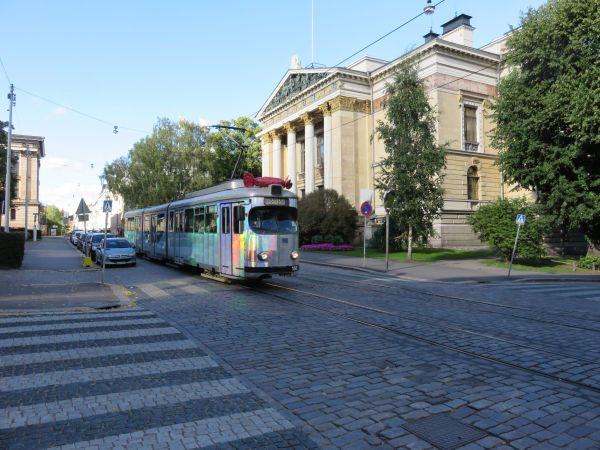
Some years back, at a time when Helsinki public traffic authority HKL had a time when they ran into trouble with their public tendering and
could not buy newer trams that they wanted, HKL bought as an interim solution very cheaply from Germany used 1960s Düwag trams from Mannheim
and Ludwigshafen. The plan was to use them only for a year or so. Some of them have been scrapped and/or sold to Poland (Lodz) by now, but
some are exeptionally long-lived. This one, no 166, is a Düwag GT8 from 1962, originally Mannheim's MVV no. 510. In 2010 it was declared a
"Culture tram". It received silvery stickers with hologram texture as an overall taping and it also received a - sorry for the comment :-) -
sausage-like piece of art (?) on the roof of the driver's cab. It was used only as a tram that someone can rent for sightseeings,
private rides and similar. Right after the silvery hologram tapings appeared, the tram got from the public a nickname "silakka" = "herring"
- well, you can figure out why. Then one day it happened that there was a minor fire in the tram. The damages were minor, but the smell remained.
Ever since then the naughty boys and girls - like myself - have called it "savusilakka", smoked herring :-D Today even this smoked herring
has been sold to Poland.
Picture of the savusilakka tram at Snellmaninkatu, Helsinki, 27.8.2016 by Ilkka Siissalo.
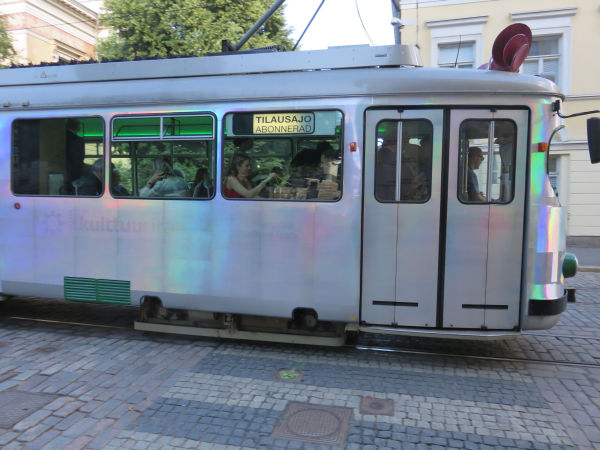
A side view of the "smoked herring" shows clearly the hologram textured silvery tapings. The tram also used to have large texts
"Kulttuuriratikka" or "Culture tram" on its sides, but today only faded glue remains show where the text stickers once have been. Photo at
Snellmaninkatu 27.9.2016 by Ilkka Siissalo.
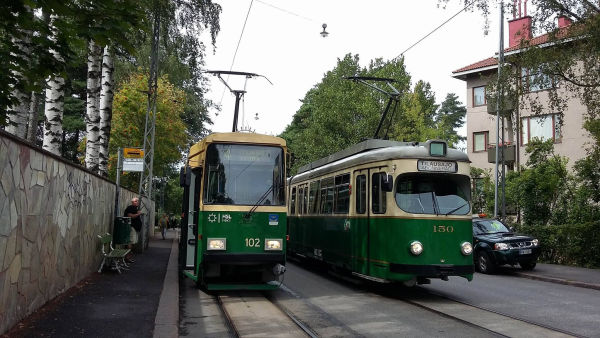
Comparison of 1970s and 1960s design. No.102 on the left is an NrII, which in 2009 got an added third section in the middle. Although built
in the 1980s, it shows the typical design of the 1970s. No.150 on the right however is a German Düwag. It was built in 1967 and it used to
be the no.150 of Verkehrsbetriebe Stadt Ludwigshafen. It was bought used to Helsinki in 2004. Today it is only used as a charter tram. Many
people in Helsinki know it by the nickname "Ludde" due to its origin in Ludwigshafen. Ludde also has in its middle an added third section.
HKL bought it originally to test if this long trams could operate in Helsinki or not. Picture in Munkkiniemi by Anne Teirisalo.
Stadin Ratikat - museum tram traffic in Helsinki
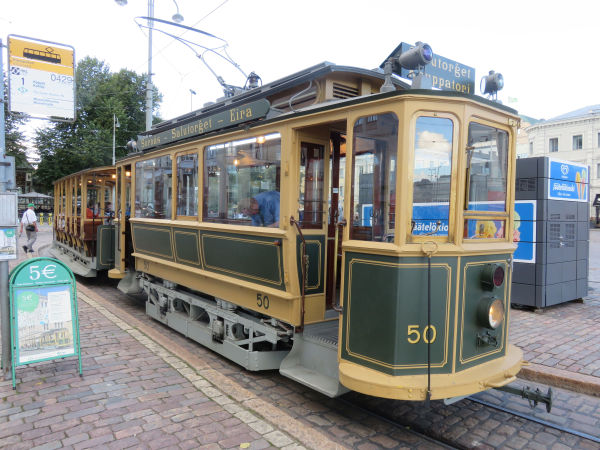
Stadin Ratikat (trams of the city) is a company which operates some museum trams on the network of Helsinki. This one is a "pikkuruotsalainen"
(little Swede) from the year 1909 together with an open summer time coach no.233 from the year 1919. During summertime this composition
or some other of the Stadin Ratikat's oldies used to offer tourists a 15 minutes sightseeing run for 5 euros.
Picture from Kauppatori (market square) 27.8.2016 by Ilkka Siissalo.
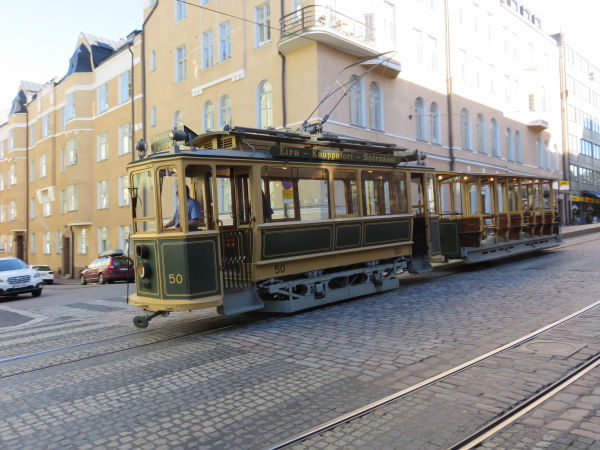
Work for the day is done and the historic composition of motor wagon no 50 from 1909 and open trailer no. 233 of 1919 are
returning empty to depot.
Picture from Snellmaninkatu, Helsinki 27.8.2016 by Ilkka Siissalo.
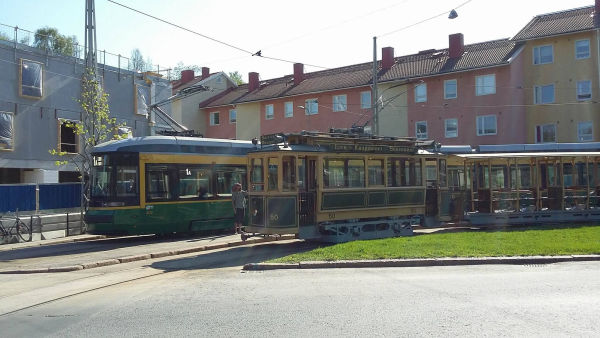
The newest and the oldest are meeting. The "Little Swede" no.50 in front is from 1909 and the prototype Artic tram no. 402 behind it is
from 2013.
Picture from Käpylänaukio in October 2016 by Anne Teirisalo.
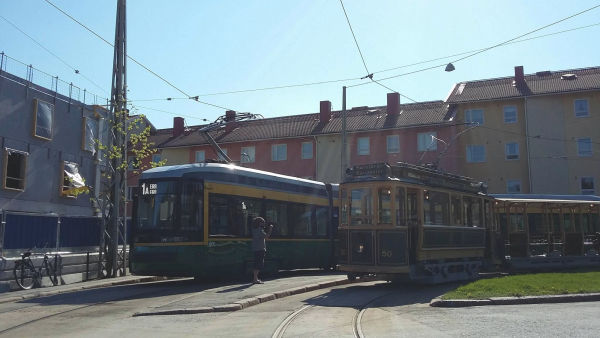
Another view of the newest and the oldest meeting in Käpylä. With a more than 100 years age difference, one could imagine they would
look more different from one another as they actually do.
Picture from Käpylänaukio in October 2016 by Anne Teirisalo.
Spårakoff tram pub in Helsinki
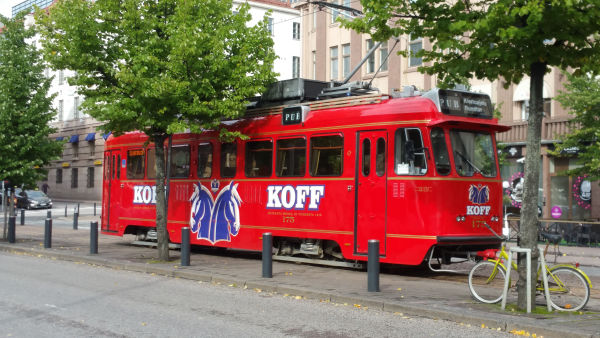
There is a pub tram in Helsinki called Spårakoff. When the well known beer brewery Koff had its 175th birthday some years back, a 1950s
old tram was converted into a rolling pub. The tram, originally HKL's no. 15, lost its middle pair of doors, a minuscule toilet was built in
and tables were fitted in for roughly 30 people. By paying 10 euros, people can now have a nice touristic ride around central Helsinki while
simultaneously sipping beer or cider. Originally Spårakoff was intended to be used just for a short time, but it became so popular
that it continues to ride year after year. The tram was originally built by Karia in Finland in 1959.
Picture from Railway square in Helsinki 22.8.2016 by Ilkka Siissalo.
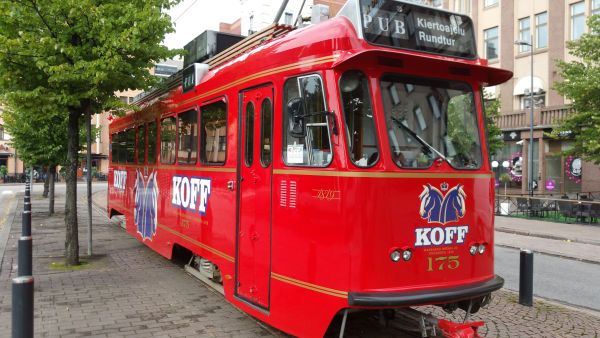
Another view of the Spårakoff pub tram. It has also lost its old fashioned headlights, which have been replaced by small and powerful
halogens. There are similar tram-pubs in other cities in Europe as well, for example in Krakow, Poland and Zürich, Switzerland. There's
also a cafeteria tram in Stockholm, Sweden.
Picture from Railway square in Helsinki 22.8.2016 by Ilkka Siissalo.
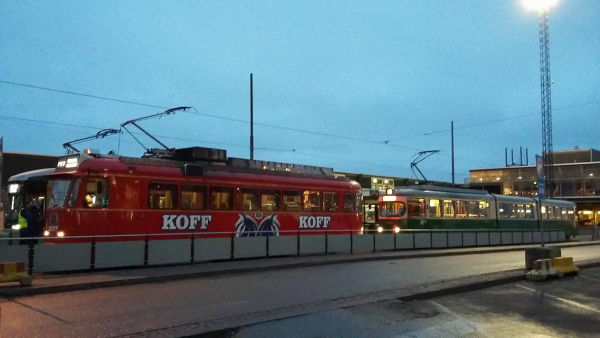
Two rarely seen trams in the same picture: The Spårakoff pub tram and HKL 150 "Ludde".
Picture 29.12.2016 by Anne Teirisalo.
Technical service trams & miscellaneous

HKL has two modern wagons for technical purposes: grinding and cleaning of the rails etc. made by the company Windhoff. Here we see
Windhoff no. 2012 (its year of manufacture) encountering another tram at Sturenkatu. Picture by Anne Teirisalo.
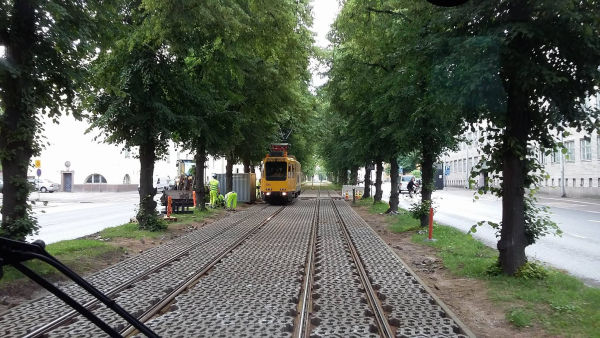
This is the other Windhoff no.2010 encountering another tram at Mäkelänkatu by construction works. Bricks with holes are being layed
and there will be a green grass mat growing through the holes. The Windhoffs have a lot of work to do during autumn season when falling
rotten leaves make the tracks slippery and they have to be sprayed or wiped clean time and time again. Mäkelänkatu with its beautiful trees is especially
difficult. Picture autumn 2016 by Anne Teirisalo.
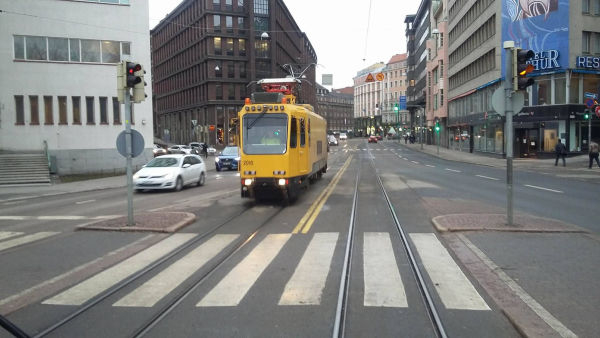
This is the Windhoff no.2010 encountering another tram at Kaisaniemenkatu near the University of Helsinki metro station.
Picture 5.1.2017 by Anne Teirisalo.
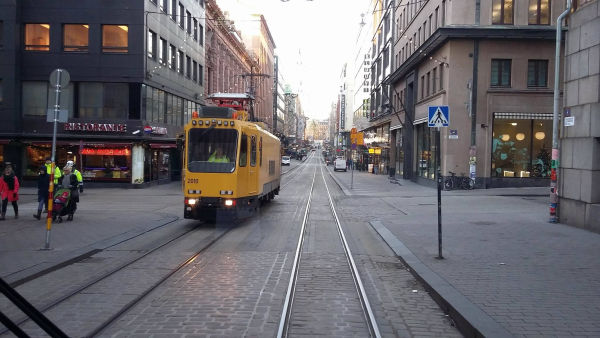
Windhoff no.2010 at Aleksanterinkatu in downtown Helsinki.
Picture 28.12.2016 by Anne Teirisalo.
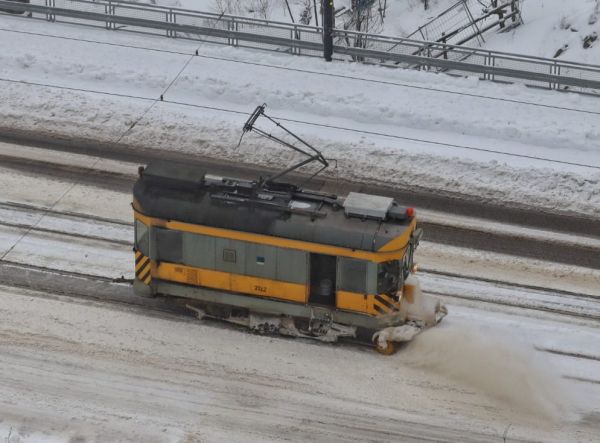
This sweeper wagon no.2122 with a rotating brush is already a really old tram, which has gone through many, many total rehauls and redesigns. It
used to be no. HKL 125, one of the so called "Big Swede" trams built by Asea and General Electric and delivered in 1928. It was used in normal
passenger traffic until 1975. Major redesigns have taken place at least in 1962, 1982 and 1996. When new, this used to be a bidirectional normal
tram with doors on both sides and a driver's cab at both ends.
Picture from the suburb of Pasila 30.1.2022 by Matti Heino.

The same brush wagon no.2122 as shown above seen a bit more from its front.
To see a similar tram during the time when they were still in active passenger traffic, see
here a photo of HKL no.123 in the year 1973.
(A link to www.raitio.org).
Picture from the suburb of Pasila 30.1.2022 by Matti Heino.
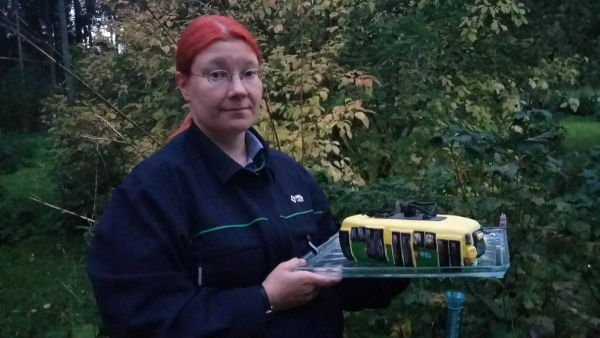
A Helsinki tram professional and her very professional tram cake: Anne Teirisalo.
Trams of City of Tampere, Tampereen Raitiotie Oy
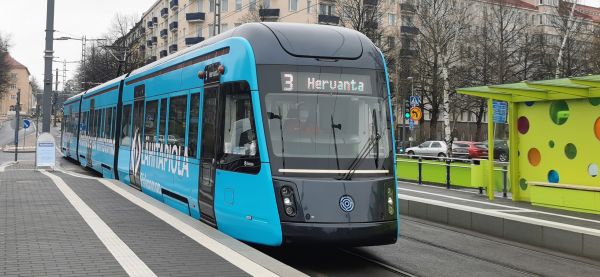
City of Tampere is Finland's newest city with a tram system, Tampere light rail. The new light rail trams run from Pyynikintori
in the city centre of Tampere to the suburb of Hervanta, where the University of Tampere has its technology campus. The line is
16 km long and built with 1435 mm gauge. 19+5 trams have been ordered from Škoda Transtech. They operate with 750 V DC and have a
top speed of 70 km/h. In future there will be two tram lines, but the first passengers got onboard the first line trams on 10.5.2021.
Picture from Tampere city centre 10.5.2021 by Kari Wikström.
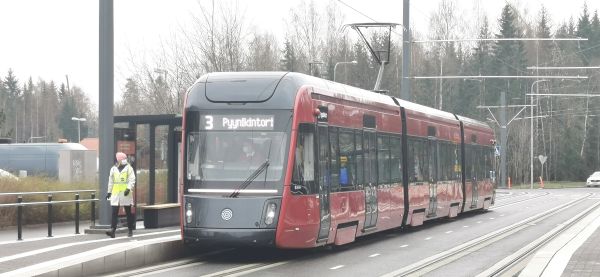
City of Tampere's new trams are in principle red, but some of them (like the light blue one shown above) are fully covered by
advertisements.
Picture from Hervanta 10.5.2021 by Kari Wikström.
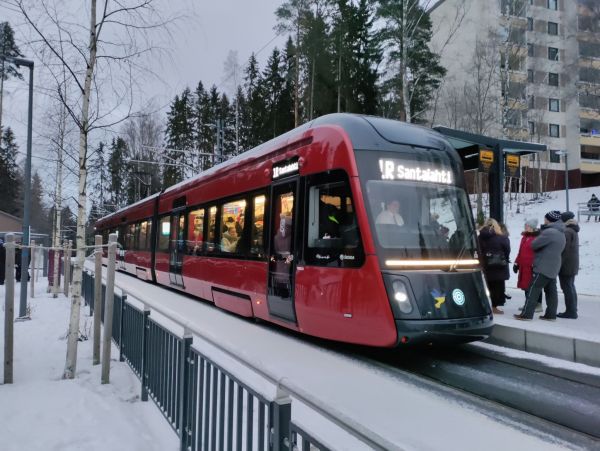
A nice wintertime shot of one of the City of Tampere trams. This is the TRO16.
Picture from Pyhällönpuisto 4.1.2025 by Juhana Nordlund.
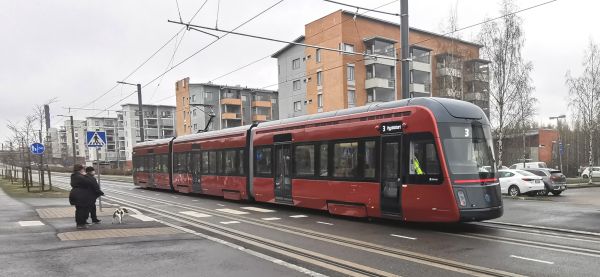
City of Tampere's new trams are of the type ForCity Smart Artic X34 built by Škoda Transtech. They are 37,3 metres long and have
driver's cabs at both ends.
Picture from Hervanta 10.5.2021 by Kari Wikström.
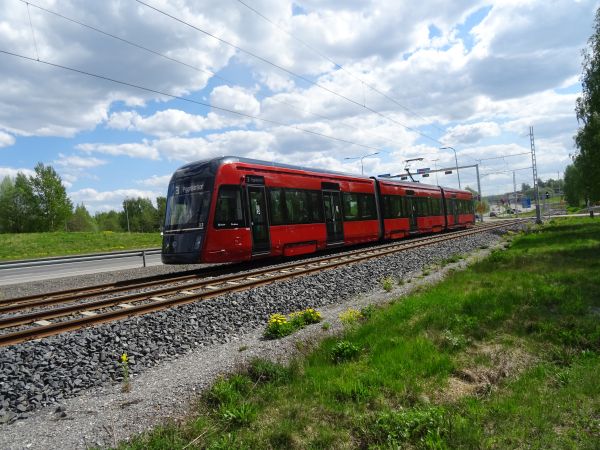
City of Tampere's TR014 seen here in full speed near the crossings of the roads Hervannan valtaväylä and Vuohensillankatu near the suburb of Hervanta.
Picture 25.5.2022 by Ilkka Siissalo.
Trams of City of Turku
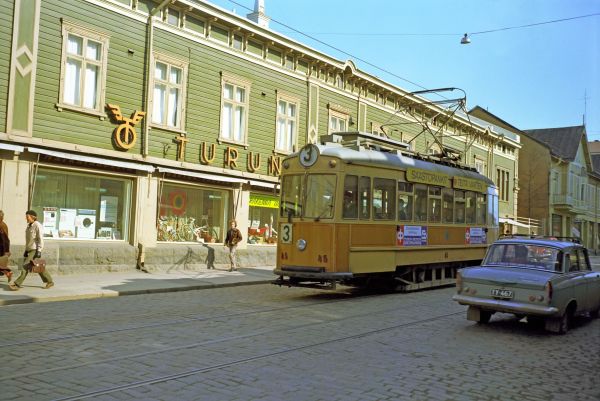
The tram network of the city of Turku was the first one in Finland. It operated with horses 1890-1892 and then as an electric tramway 1908-1972.
There were four tramlines.
City of Turku's tram no 45 was built by the company Karia with electric parts from Strömberg. These trams were used 1951-1972. Here we see it in
the corner of the streets Humalistonkatu and Rauhankatu in Turku 15.4.1972.
Picture by Juhani Katajisto.
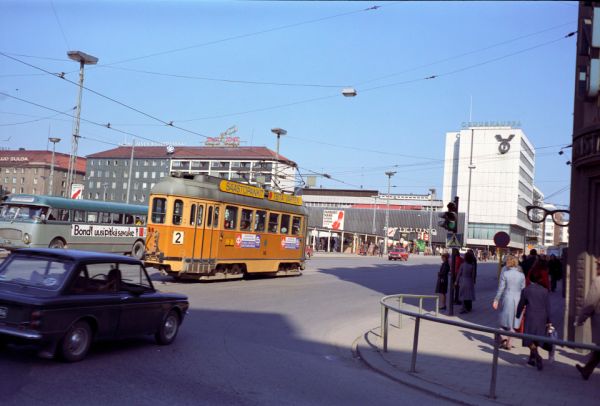
The city of Turku had also four axle trams with bogies built by Valmet, Tampella and Strömberg in the 1950s. They moved so silently that the
inhabitants of the city of Turku gave them the nickname "aavevaunu" (ghost wagon) because it was difficult to hear an approaching tram.
The basic design of these trams was copied from the so called Swiss standard trams, but the third pair of doors in the middle of the wagon
was left out and these trams of Turku also used newer and bigger bogies. Same type of bogies were later used also in the Valmet trams
numbered in the 300 series in Helsinki.
Picture by Juhani Katajisto from the market square of Turku 15.4.1972.

